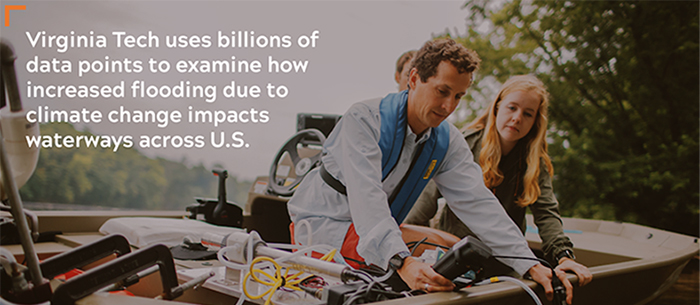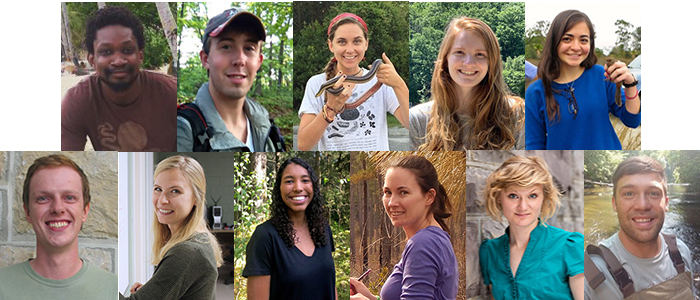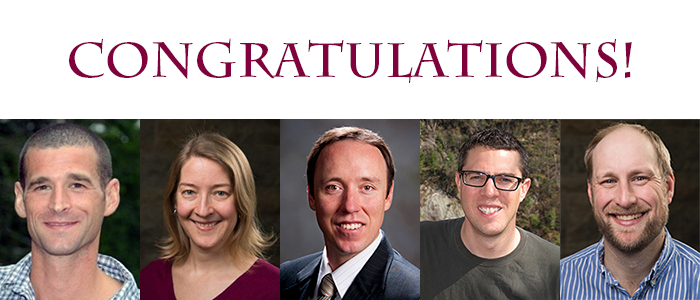[vc_row][vc_column][vc_column_text]
From CALS VT News | June 30, 2020
There’s a tendency in modern America to think of flooding as nothing but dangerous, a threat to homes, farms, roads, and bridges. But flooding — when the waters of a river rise above the banks and inundate the nearby land — is a natural phenomenon that benefits wildlife habitat and has been crucial for human civilizations ever since the first ones relied on the flooding of the Tigris, Euphrates, and Nile rivers to irrigate their crops.
Durelle Scott, an associate professor of Biological Systems Engineering affiliate of the Global Change Center at Virginia Tech, is the lead author of a paper recently published in the academic journal Nature Communicationsthat examines flooding in the continental United States in nearly unprecedented detail. Scott and his co-authors looked at what Scott calls “everyday” flooding in streams and rivers of all sizes, using data from 5,800 flood monitoring stations operated by the United States Geological Survey. With measurements typically taken every 15 minutes or every 30 minutes, that amounted to more than 2 billion individual measurements. For every station, the team performed 1,000 realizations of flooding thresholds to capture uncertainty, applying statistical techniques on a large computer server.
“The big picture is that flooding across the world is increasing with climate change, but not all flooding is bad and catastrophic,” said Scott, who is in both the College of Agriculture and Life Sciences and the College of Engineering. “We wanted to do an analysis where we captured the variability in annual flooding that occurs within small streams to larger rivers.”
Most flood studies are focused on single river basins or geographic regions, he said. By studying the entire lower 48 states, Scott and his team can examine flooding in both large and small rivers and conclude the entire nation could better manage its floodplains.
Among the paper’s findings: smaller streams flood more often than larger ones, but for shorter durations. The more frequent flooding means that smaller streams serve as a conduit between the landscape and the adjacent stream.
That’s a mixed blessing: “Delivery of nutrients and sediment to floodplain environments is partially why you have very rich soils and agriculture set up along river systems,” Scott said. But the movement of nutrients and sediment goes both ways, and when it moves from the floodplain into the river, it can be harmful to water users downstream.
“When excess nutrients get into a stream or river and are delivered downstream, you end up with algae blooms and the like, and that has implications whether it’s related to human health or detrimental to commercial or recreational fisheries,” Scott said.
One of Scott’s findings is that the exchange of sediment and nutrients between rivers and floodplains depends not just on the levels of flooding, but on how long a flooding event lasts.
“If you have very short floods, you’ll end up having more net delivery from the floodplain into a river than removal of a specific nutrient or sediment,” Scott said. “That was unique in our study. We were able to quantify approximately how long water was on these floodplains and found for small streams the inundation is usually much less than a day, so there’s not usually an opportunity for removal of nutrients.”
This has implications for wetland restoration intended for water quality benefits. There has been much money and effort spent in recent decades to return rivers and floodplains to something resembling their natural state. This type of restoration, Scott said, must go beyond simply reconnecting a stream to a floodplain, by removing channels or levies that once contained the stream. If the water only tops the stream banks during high flows, flooding will be short and heavy, which could send more harmful material downstream. Instead, restoration within mid-sized rivers may produce more gradual flooding, to achieve what Scott called “the balance of optimal inundation time and nutrient supply for water quality benefits.”
Scott’s research could also have lessons for how we manage rivers to prevent catastrophic flooding. Serious flooding is certainly something to be prevented, but we may be over-protecting ourselves against moderate flooding to enable construction on low-lying floodplains.
“We’ve put in lots of levies to reduce infrastructure damage,” Scott said. “The flipside is if you put up a levy in a town and a town downstream doesn’t have as big of a levy, you’re making it worse for the downstream community. With more frequent flooding on the horizon, future water management needs to balance economic development within flood-prone areas relative to the societal costs of post-flood reconstruction.”
Written by Tony Biasotti
[/vc_column_text][/vc_column][/vc_row][vc_row][vc_column][vc_separator style=”shadow”][/vc_column][/vc_row][vc_row][vc_column][/vc_column][/vc_row]









